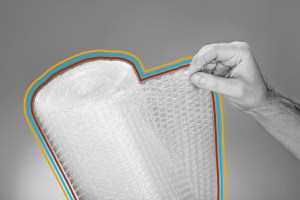
Gas Tank Side Indicator
It can be hard to remember what side your gas cap is on, especially in a car you’re not used to driving. Fortunately, there’s usually a pretty easy way to tell: In many cars, there’s a little arrow next to the gas symbol on your fuel gauge that points to the side of the car that should be facing the pump. This tiny, easy-to-miss feature can save you a whole lot of awkwardness pulling a rental car into the gas station. Even if you’re pretty sure your car doesn’t have it, double-check — it’s sneaky!

Tire Pressure Monitor
If you’re used to driving a car from before 2008, there’s a new standard dash light that may look unfamiliar: a yellow exclamation point in the middle of what looks like two parentheses with a dotted line below. It’s supposed to look like a cross section of a tire, and that light tells you that your tire pressure is low. Some cars have more fully featured tire pressure monitors that show all four wheels.
The dash light is designed to illuminate when at least one of your tires is 25% below the recommended tire pressure. If you’re seeing it, either check your tire pressure or head to a tire store — many of them will check for free. (But remember that you should be checking your tire pressure monthly anyway; tire pressure can become dangerously low before this light comes on.)
The indicators became mandatory in American vehicles after the United States Congress passed the TREAD act; the bill was from 2000, but the requirement didn’t kick in until 2008. Some car manufacturers got a head start and started including them in 2006 or 2007 models, too.

Stability Control
Do you sometimes see a dash light that looks like a car with wiggly lines underneath it? That means you have an electronic stability control (ESC) system, sometimes called vehicle stability control, electronic stability program, or dynamic control system. It closely monitors your steering to determine when your car might be out of control, and softly adjusts the brakes on each wheel to compensate for over- or understeering and to prevent rollovers.
If you see the dash light flickering, chances are the system has been activated and is trying to keep your car on track, or driving conditions are just slippery. If it’s steady, it could mean the system is malfunctioning. Some cars have a button that can turn it off.
More Interesting Reads

Backup Mechanical Keys
If you drive a newer car, chances are you’re not turning a key in the ignition. Key fobs have become the standard way to unlock vehicles, which is convenient until your key battery dies or you have some other kind of tech malfunction.
The good news is that you might have a lower-tech backup plan built right in. Many key fobs have little mechanical keys hidden inside that you can usually release by pressing or sliding a small button, although you may have to check the owner’s manual to figure it out. Some key slots are better hidden than others; yours could be right next to the unlock button on the door, underneath the door handle, or under some sort of cap.

Secret Storage Compartments
Whether you have something to hide or you’re just trying to squeeze a little extra storage out of your vehicle, it’s worth looking for secret pockets of space.
Some Toyota Prius models have storage underneath the floor of the trunk. The Buick Enclave has both subfloor storage and a false floor under the center console. The Infiniti G35 had a flap in the rear armrest with a small compartment behind it. Some Volkswagen models even have a little drawer under the driver’s seat that’s perfect for documents.

Blind Spot Monitoring
The rear sides of your car are called “blind spots” for a reason — they’re really hard to see, and even if you dutifully check them before changing lanes, accidents can happen. Some newer cars (and some not-so-new luxury vehicles) come with blind spot monitors (BSMs) that let you know when a car’s occupying this sneaky spot next to you. Some of these monitors are more obvious than others. It could be lights on your side mirrors, dashboard, or the pillar between your driver’s side window and your windshield. A few cars even have audible warnings if your turn signal is on but the lane next to you is occupied.
Even lower-end cars have BSMs now, but some higher-end indicators go above and beyond and steer your car away. A couple of trucks even have BSMs that extend to the trailers they’re towing. Just make sure to keep using your eyes — the monitors aren’t foolproof, and often miss vulnerable road users like pedestrians and cyclists.

Shortcut for Rolling Down Your Windows
If you look at your key fob, you’re probably not going to see a button that rolls down your windows, but that doesn’t mean it can’t do it. Check your manual, because sometimes a specific key sequence can lower all your windows from outside the vehicle so you can cool it down on a hot day. It’s not just newer models, either — cars more than a decade old have this function, too.
Even if you’re not planning on using this feature, you should at least figure out how not to do it by accident.











